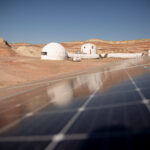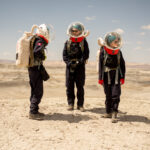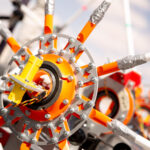Journalist Report – May 11th
Crew 261 Journalist Report 11-05-2023
Author: Kris Davidson, Crew Journalist
The awe-inspiring images of astronauts soaring through the cosmos will forever capture our imaginations. They are the main characters, the faces we associate with the ongoing saga of space exploration. While we extol these pioneers in the limelight, it is equally important to acknowledge the ones laboring tirelessly behind the scenes — the ones we know as Mission Support.
The successful and safe human exploration of Mars will necessitate a complex network of mission support. This endeavor will encompass extensive pre-mission training, development, and maintenance of comprehensive life support systems, including breathable air, clean water, food, health monitoring, and medical care. The formulation and rehearsal of contingency plans for emergencies will be essential. Robust communication systems need to be established. Lastly, the scientific objectives of each mission will necessitate ongoing, adaptable support capable of accommodating discoveries as they arise.
On Sol 10, during EVA 16, Sergii Iakymov’s voice echoed through the lower hab, warning Commander James Burk of a sudden weather shift and advising an immediate EVA termination. This instance is but one among many where our crew has benefited from the guidance of Mission Support. As crucial on Mars as it is at the MDRS, Mission Support is instrumental to the success of every mission. With crews cycling through, Mission Support remains the constant, the steady sentinels of this place. Their intimate knowledge of the MDRS structures and surrounding landscapes is invaluable. They establish and maintain crucial relationships in Hanksville and beyond, coordinate supplies between missions, and impart vital knowledge and insight to each incoming crew while ensuring the integrity of each simulation. On this penultimate Sol on Mars, the Transatlantic Mars 261 crew extends our heartfelt gratitude to Mission Support — Dr. Shannon Rupert and Sergii Iakymov. We could not have achieved this without you.
As Sol 11 dawned, the Transatlantic Mars Crew 261 is commencing the final stages of their experiments and projects, embarking on their final EVAs. EVA 18 set out for the Sea of Shells region to conduct the final tests on the Atmosphinder robot and to observe the geological features of the region. The participants, including Crew Engineer Julien Villa-Massone (EVA Leader), GreenHab Officer Cecile Renaud, Crew Roboticist Erin Kennedy, and Journalist Kris Davidson expressed a deep sense of gratitude for their mission experience. Back at the hab, Commander Burk and Executive Officer Aline Decadi worked on the final mission report, a critical communication with Mission Support and the larger Mars Society community at the end of a mission.
Space exploration is not solely a tale of astronauts and their heroic exploits. It is equally a story of the people comprising Mission Support who ensure the success and safety of each voyage. Their commitment and tireless efforts enable the astronauts to carry out their missions effectively, while simultaneously ensuring the integrity and continuity of each mission. Without them, the mesmerizing images of astronauts floating in space would remain a distant dream.
EVA Report – May 11th
Crew 261 EVA Report 11-05-2023
EVA # 17
Author: James Burk (Commander)
Purpose of EVA: Soil Gathering for Crew Biologist
Start time: 7:30 AM
End time: 8:15 AM
Narrative:
Overview of EVA
This was essentially a repeat of our crew’s EVA-3 to collect soil samples south of the campus. Commander Burk and Crew Renaud took Perseverance out to the same locations as EVA-3, collected soil, and returned without incident.
Issues Experienced
- None
Outcomes
None
Destination: North side of Kissing Camel Ridge, just off Cow Dung Road.
Coordinates (use UTM WGS 84): 518300 E, 4249500 N
Participants: James Burk (Commander) (EVA Leader), Cecile Renaud (GreenHab Officer).
Road(s) and routes per MDRS Map: Drive towards Cow Dung Road, take it south to the entry to Robert’s Rock Garden, and walk east to collection site.
Mode of travel: Rover (Perseverance)
Crew 261 EVA Report 11–05–2023
EVA # 18
Author: Erin Kennedy (Crew Roboticist)
Purpose of EVA:
Final testing of Atmosphinder robot
Observe the geological features of that region
Start time: 1:19 PM
End time: 4:37 PM
Narrative:
Overview of EVA
Today was the final testing of the Atmosphinder robot! Fixes were implemented that solved all of the problems from EVA-16 (yesterday). As a final test, the objectives were to test: 1) autonomous function activation based on anemometer wind speed and 2) computer vision with coloured card sequences.
1) Autonomous sensor-based function activation with the anemometer
The anemometer was activated, and the robot responded by changing the sail servo motor movements and LEDs. As the wind speed value hit different thresholds, the sail servo movements changed accordingly. Due to lack of wind, the anemometer was given a manual spin for the test. Two functions were tested, and both worked as expected. The result was prominent today owing to the servo motors functioning and the LEDs being brighter.
This test result proves that Atmosphinder was able to control its sail trim servos in response to the wind speed. This is an indicator that in the future, controlling the direction of the robot based on the current winds is possible.
2) Human-Robot Interaction experiment to activate functions based on coloured card sequences
EVA crew members Cecile and Julien showed the robot pink and green cards, and the robot responded by moving its sails accordingly. The EVA crew members then swapped positions, making the combination green and pink, and the robot responded by moving its sails in the other direction.
This test result proves that this is as an alternate method for human-robot interaction for astronauts, and is worth exploring further to improve the usability. This interaction style will be important when humans and robots need to collaborate on the surface of Mars.
Challenges were experienced regarding the positioning of the cards in front of the camera, and the angle of the cards as to not introduce any shadows onto them. The evaluation of a better technology, as reported in the EVA-16 report, still stands. Today the lighting conditions outside matched those that were used for training the embedded computer vision system. Benchtop testing was conducted prior to the EVA to confirm the camera could detect the coloured cards.
Conclusion
As a final destructive test, the robot was extracted from the rover and attempted to roll down a gentle hill at the Sea of Shells destination. Due to the warmer temperatures, the hot glue repairs became disconnected. This resulted in the structure not being sturdy enough to roll for a single revolution. This was not detrimental to the overall testing as all of the functional testing was completed earlier in the EVA.
EVA-18 was an extraordinary conclusion to the Atmosphinder project. The functionality worked, making it a wonderful culmination of the efforts for the past two weeks. Sharing the enthusiasm with the entire crew was extremely rewarding! Many thanks to the entire crew for contributing to this final EVA to make it a favourable result.
Issues Experienced During EVA-18
None
Outcomes
1) All Atmosphinder testing worked!
2) Obtained rock samples
Destination: Sea of Shells
Coordinates (use UTM WGS 84): 516400 E, 4255400 N
EVA Participants: Julien Villa-Massone (Crew Engineer) (EVA Leader), Cecile Renaud (GreenHab Officer), Erin Kennedy (Crew Roboticist), Kris Davidson (Journalist) (Not In Sim – Not Wearing Suit)
Road(s) and routes per MDRS Map: Cow Dung Road north to Brahe Hwy 1572, then north turn and stop at Sea of Shells
Mode of travel: Rovers
Vehicles you will be using (If applicable): Curiosity and Opportunity
Operations Report – May 11th
Crew 261 Operations Report 11-05-2023 Update #1
SOL: 11
Name of person filing report: Julien Villa-Massone
Non-nominal systems:
· Remote observatory
· 1 Helmet, 1 headset
· Some electric outlets in the kitchen
Notes on non-nominal systems: Failed helmet and headset are set aside and labeled as such.
Electric outlets failed on the sink side of the kitchen. A cord extender has been installed to temporarily replace these outlets.
ROVERS
Spirit rover used: No
Hours: (before EVA) 221.5
Beginning charge: (Before EVA) 100
Ending charge: (On return from EVA, before recharging) N/A
Currently charging: Yes
Opportunity rover used: Yes
Hours: 127.3
Beginning charge: 100
Ending charge: 70
Currently charging: Yes
Curiosity rover used: Yes
Hours: 238.2
Beginning charge: 100
Ending charge: 63
Currently charging: Yes
Perseverance rover used: Yes
Hours: 264.0
Beginning charge: 100
Ending charge: 72
Currently charging: Yes
General notes on rovers: Nominal operation
Summary of Hab operations: Nominal day
WATER USE: rate of 40 gallons / sol today. Trend since mission start of 30 gal/day including 120 gal resupply. We will now finish the mission with 28 gallons extra if usage continues as per current trend.
Water (static tank): 191 gallons remaining
Static tank pipe heater (on or off): off
Static tank heater (On or off): off
Toilet tank emptied: no
Summary of internet: Nominal
Summary of suits and radios: Nominal
Summary of GreenHab operations: Nominal.
WATER USE: 11 gals total
Heater: Off
Supplemental light: Off
Harvest: Spinach (11g), lettuce (27g), microgreens (23g), Tomatoes (861g), Mustard spinach (65g), sage (10g), Thym (17g), 4 black carrots (27g of black carrots harvested today).
Summary of ScienceDome operations: Nominal.
Dual split: Off
POWER report: Nominal.
Summary of RAM operations: Nominal
Summary of Tunnels maintenance: No zip-ties added.
Summary of any observatory issues: Nothing to report
Summary of health and safety issues: Nominal.
Questions, concerns and requests to Mission Support: Thank you for your support today.
GreenHab Report – May 11th
Crew 261 GreenHab Report 11-05-2023
GreenHab Officer: Cécile Renaud
Environmental control: Door open from 6:30 to 18:40
Average temperatures: 54.3°F at 06:30, 84.3°F at 11:10, 91.6°F at 12:30, 81.5 at 18:40
Hours of supplemental light: N/A
Daily water usage for crops: 4 gal at 07:15 + 6 gal at 19:00
Daily water usage for research and/or other purposes: 1 gal (including watering solution for biostimulant exp)
Water in Blue Tank 156 gallons
Time(s) of watering for crops: 06:30 and 18:40
Changes to crops: N/A
Narrative: N/A
Harvest: (include which crop and mass in grams) : Spinach (11g), lettuce (27g), microgreens (23g), Tomatoes (861g), Mustard spinach (65g), sage (10g), Thym (17g), 4 black carrots (27g of black carrots harvested today).
Support/supplies needed: None
Sol Summary – May 11th
Sol 11
Summary Title: Wonderful culmination of team efforts
Author’s name: Aline Decadi, XO
Mission Status: nominal
Sol Activity Summary: Today took place 2 EVAs:
– EVA-17 with the following 2 crew members: James Burk (Commander) (EVA Leader), Cecile Renaud (GreenHab Officer).
– EVA-18 with the following 4 crew members: Julien Villa-Massone (Crew Engineer) (EVA Leader), Cecile Renaud (GreenHab Officer), Erin Kennedy (Crew Roboticist), Kris Davidson (Journalist) (Not In Sim – Not Wearing Suit).
EVA-17 successfully conducted soil gathering for Crew Biologist. The crew drove the rover Perseverance to the North side of Kissing Camel Ridge, just off Cow Dung Road.
EVA-18 had the following purpose:
- Final testing of Atmosphinder robot
- Observe the geological features of that region
The EVA-18 started close to the RAM, then the crew drove with the rovers Curiosity and Opportunity to Cow Dung Road north to Brahe Hwy 1572, then north turn and stop at Sea of Shells.
Today was the final testing of the Atmosphinder robot! The robot response was prominent owing to the servo motors functioning and the LEDs being brighter compared to EVA-16.
The anemometer was activated, and the robot responded by changing the sail servo motor movements and LEDs. As the wind speed value hit different thresholds, the sail servo movements changed accordingly. This test result proves that Atmosphinder was able to control its sail trim servos in response to the wind speed. This is an indicator that in the future, controlling the direction of the robot based on the current winds is possible.
EVA crew members Cecile and Julien showed the robot computer vision camera pink and green cards, and the robot responded by moving its sails accordingly. The EVA crew members then swapped positions to change the colour combination, and the robot responded by moving its sails in the other direction. This test result proves that this is as an alternate method for human-robot interaction for astronauts, and is worth exploring further to improve the usability when collaborating with robots.
EVA-18 was an extraordinary conclusion to the Atmosphinder project. The functionality worked, making it a wonderful culmination of the efforts for the past two weeks. Sharing the enthusiasm with the entire crew was extremely rewarding! Many thanks to the entire crew for contributing to this final EVA to make it a favourable result.
The crew spent the rest of the afternoon debriefing. Julien Villa-Massone (Crew Engineer) performed a demonstration on the resources in the Hab (power supply and water). Erin Kennedy (Crew Roboticist) made a demonstration of the functions and performances of Atmosphinder. Then, the crew made the daily reports, have dinner together. The crew discussed the “remain to do” for the last day in Sim tomorrow and prepared the last EVAs tomorrow.
In the Greenhab, some activities have been anticipated for tomorrow by Cecile Renaud (Greenhab officer), such as the characterization of the soil with the plants, and the counting of the number of seeds visible from the top of the soil. It remains tomorrow to check for potential sprouts to be detected. Regarding the photoreactor: harvest training has been done with James Burk (Commander); he will be able to teach the harvest process to the next crew. Moreover, the volumes of the culture have been increased at their maximum volume.
Look Ahead Plan: we will conduct our last 2 EVA tomorrow: EVA-19 in the morning for scouting the area South to the Gateway of Condor; EVA-20 in the afternoon for exploring the geological features at Sea of Shells, according to mission request approval.
Anomalies in work: None.
Weather: Pleasant and sunny. Windy in the afternoon.
Crew Physical Status: Nominal.
EVA: EVA-17 North side of Kissing Camel Ridge, just off Cow Dung Road; EVA-18 at Sea of Shells.
Reports to be filed: HSO Report, EVA Report, Operations Report, Journalist Report, Pictures of the day, GreenHab Report.
Support Requested: None.










You must be logged in to post a comment.